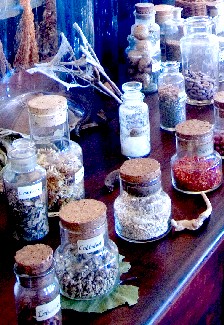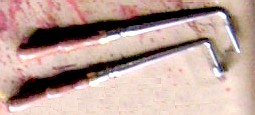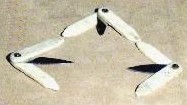
Gangrene Treatment Page Menu: 1 2 3 4 <<First
Treating Gangrene During the Golden Age of Piracy, Page 4
Curing a Gangrene - Medicines
We had a hint at the use of some medicines which were applied to scarified, gangrened parts on the previous page. Several authors suggest a more traditional use of medicines to help combat the effects of gangrene. Since they are the primary treatment recommended by Matthias Purmann, we begin with his recommendations.
"The Cure of this pernicious Affect, consists in such Medicines as have virtue to attenuate stagnated Liquors [blood and bad humors], temper the Acidity and Acrimony, and prevent Rottenness and Mortification; besides you must provide your self of such things as are proper to allay the Heat and Inflammation...
 Cataplasm [a poultice] is to be used when a Mortification is begun and is an excellent one in
such a Case." (Purmann, p. 208)
Cataplasm [a poultice] is to be used when a Mortification is begun and is an excellent one in
such a Case." (Purmann, p. 208)
Purmann goes on to give several complex recipes for medicines to treat gangrene, although their complexity and abbreviated Latin text makes them all but incomprehensible for the casual reader and surgical writer. Richard Wiseman gives several specific suggestions of a simpler nature.
"...foment the Part with a Lixivium [lye] in which have been boiled scordium [water germander], absinth. [a wormwood tonic] centaur. and the like. You may also apply over all a Cataplasm of Barley-meal, Lupines, with the addition of such Ingredients as have been prescribed in the Chapter on Gangræna. But if Itching affect the Part, then foment it with warm Water, which will give a breathing to it by the Pores; or with Salt-water, quæ propter salem expurgat & poros aperit [which, because of the salt, opens pores and eliminates it.] The itching neglected is wont to terminate in excoriationem dolorosam [stripped painful], in a very painful Excoriation…" (Wiseman, p. 471)
Pierre Dionis has much to say about medicines used for preventing gangrene.
"To avoid the ill consequences of a Contusion [gangrene], we are to bleed the Patient several times, obliging him withal to take a little Glass of Vulnerary Water [A mixture of vinegar, alcohol, dilute sulphuric acid, honey, and water; at one time used in the treatment of wounds], into which we are to put half a Spoonful of Fiovoranti's Balsam, or else dissolve two Drams of Confection of Hyacinth [a complex astringent mixture] or Alkerines [Alkermes - an Italian liquor] in an Ounce of Brandy, and cause the Patient to swallow it immediately: We are to order to be boil'd in Wine the Aromatic Herbs, as Sage, Rosemary, Hysop [Hyssop], Fennel and Marjoram, in which Decoction we are to dip the Bolsters [cushions], which we are to lay hot on the Part, frequently renewing them." (Dionis, p. 404-5)
Curing a Gangrene - Diet
John Woodall recommends a diet to be used to prevent gangrene from occurring in wounds that are susceptible to it. Woodall was a big fan of natural healing methods, extolling them in several places. For example, he explained that "Nature will better cast it [foreign matter] out then thou canst by arte devise to do it, and over forwardnesse [to much surgical intervention] doth often as much hurt as good." (Woodall, p. 11) With regard to gangrene, he suggested a diet in addition to medicines.

John Woodall
"Gangrene unawares assaulting the party: also a posthumation, dolor, and the like.
Wherefore as an entrance to the cure, let an universall regiment of the sicke be carefully observed, namely that as much as is possible, hee use wholsome aliments, such as resist putrefaction (as sowre and tart things) and which are gratefull to the vitall faculties: and when he eateth let it be sparing and often, let him drinke very litle wine.
If you feare venomous vapors may be gathered, give him of good Mithridate [a complex concoction used as an antidote to poisons], Venice Trekell [Venice Treacle - same as theriac] {dram} ss.
These rules at Sea are not so well to be observed as at Land: wherefore let the Sea-Surgion therein doe his best, let his ordinary drinke be Ptisans, or barley water: Conceale from him the magnitude of his wound: keepe him loose onely with glisters [enemas], or suppositories: let him bloud if neede be, and yet but a litle, lest poyson or venome setled in the outward parts, be thereby drawne in backe into the more noble parts: and abstaine to give him remedies calefying the humour, especiall at first." (Woodall, p. 141)
The Pirate Surgeon's Recommended Procedure
For those pirate surgeon re-enactors desiring to explain how gangrene was treated during the Golden Age of Piracy, I recommend the following points, based on the preceding text.

- Explain the period-believed differences between gangrene - which was thought curable - and sphacelus - which was not.
- Note that it was understood at this time that gangrene resulted from a lack of blood flow to the gangrened part.
- Mention that the sphacelus is considered differently today - the dead skin that results that lack of blood flow.
- Indicate some of the causes of gangrene identified by period authors including: ulcers, cold (think frostbite), overly-tight bandaging, illnesses or 'fevers', lack of circulation due to old age, applications of caustic medicines (also called 'potential cauteries'), cutting corns, trimming nails and 'the bitings of venemous animals.' (I particularly like that last phrase.)
- You might note that overly-tight bandaging was widely identified as a cause of gangrene by all the surgical authors.
- Explain the signs of gangrene described at this time: redness and pricking in the skin, followed by paleness and lividity (dark purple or red skin) giving way to loss of feeling and heat in the affected part and ending with black skin. (Seriously, go look up gangrene in Google Images.) If you're like me, you may also want to mention the phrase, 'fœtid smell' when describing the last stages.
- Explain that gunshot wounds with blackened skin were sometimes confused with gangrene - it makes for an interesting point.
- Discuss treatments in whatever detail you feel comfortable. Start with the universal cure of bleeding.
- Then proceed to scarification (a good reason to get yourself some fleams) and the application of medicines to the scarified skin.
- Discuss cauterization, mentioning how some authors used it and others preferred not to. (This is a good place to

Mission's cautery irons - from G. Godwin Gedney show off your cautery irons.)
- Note that medicines were given by some authors and if you can remember all that stuff above, talk about that. (I rarely remember medicines - but I'd shoot for cataplasm and lixivium/lye. Lixivium is fun to say.)
- Finish with Woodall's suggestion to rely upon a 'spare diet ' and 'little wine' along with Woodall's beloved clysters/enemas. (This is a good reason to get a pewter clyster syringe. eBay is your best bet.) It's always fun to tell people a wound requires temperance. It gives them something to grouse about.

Mission's fleams

